We are reader-supported. When you buy through links on our site, we may earn an affiliate commission. Learn more
Are European Blueberries Good For You? Better Than US Ones?
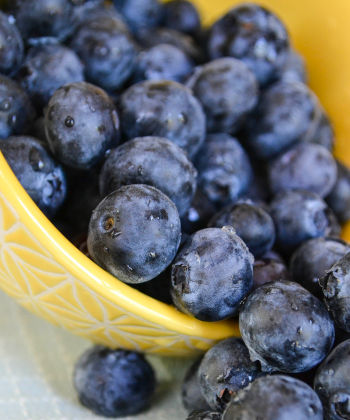
You might have heard that blueberries are good for you.
But when talking about super foods that’s good for you; There isn't much that can beat the European blueberry or Bilberry as some call it!
It beats the American Blueberries by a wide margin!
In Scandinavia, where there's a lot of the European blueberries, there's no such thing as European Blueberries.
It's just blueberries. Directly translated from Swedish, Danish, Norwegian and Icelandic the word “blåbär” is translated to blueberry (as "blå" is blue and "bär" is berry").
It’s the Finnish word that differs some. The word is “mustikka” which describes the berry as black rather than blue.
In Sweden, blueberries are one of the most common plants. Blueberries thrive in pine forests and they cover almost 17% of Sweden's surface.
Botanically, however, the European blueberry bush is called a dwarf tree, since it has a small main stem and branches that form a leaf crown.
Table of Contents
European Compared To American Blueberries
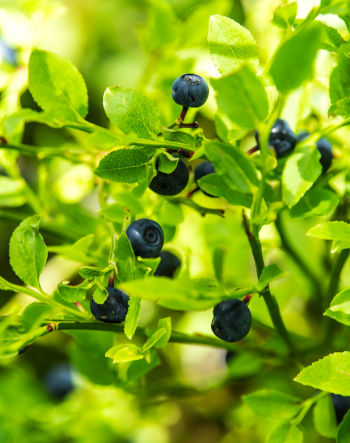
The European blueberry, Vaccinium myrtillus, is small and dark blue, almost black.
The berries pulp is red or purple and is full of nutrients.
The coloring of the berry is very strong and stains everything it comes in contact with. The stains are also quite difficult to remove.
The European blueberry is hard to cultivate and is almost always handpicked in the wild.
The American blueberry, Vaccinium corymbosum, is bigger than the European and quite easily cultivated.
The berry has a light green pulp which has a lower concentration of nutrients.
It comes in two variations, the high bush and the low bush.
The cultivated low-bush blueberries are often marketed as wild berries but naming them wild berries doesn't make them the same as the berries that are actually picked in the wild.
The European and the American Blueberries differ in size and taste
Here's an easy way to distinguish the European and the American blueberries from each other.
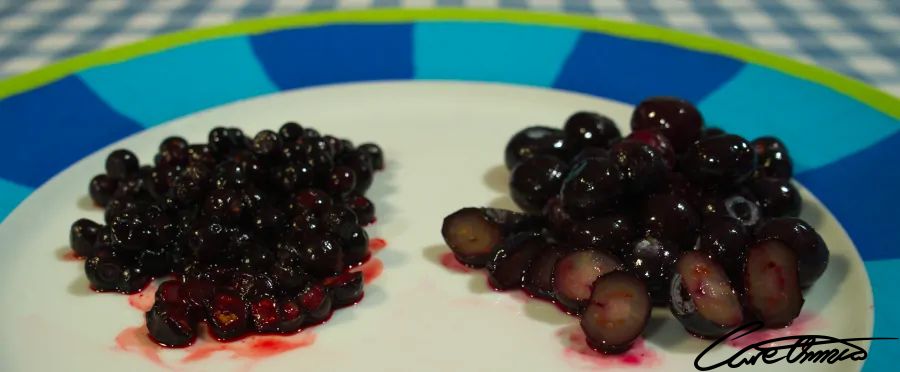
The European blueberry usually measures about 3/32 to just short of 1/4 inch (3 to 6 millimeters) in diameter while the American blueberries measure roughly 5/16 to just short of 3/4 inch (8 to 18 mm) in diameter.
The European blueberry is softer compared to the American blueberry, and the taste is sweet, with a slightly more distinct tart and acidic quality.
European Blueberries As Supplements
Much of Europe's wild blueberries are picked and exported to Asia where they end up in factories that produce nutritional supplements mainly due to the high concentration of the valuable antioxidants contained in blueberries.
These dietary supplements are then exported back to Europe and the rest of the world and are sold at pharmacies and health food stores.
Pesticides In Blueberries
One thing that I recommend you think about when buying blueberries is the question of the amount of pesticides used to grow them.
We’ve written an article about Pesticides in blueberries. The wild grown European blueberry doesn't contain pesticides for the simple reason that they aren't sprayed, while all blueberries that are cultivated are usually sprayed with pesticides.
If you want to read about our findings I recommend you read our article titled Are Wild Blueberries Sprayed With Pesticides? [Yes and No!].
If you still want to buy cultivated blueberries, I suggests that you take the organic ones. They are more likely to be without pesticides or pesticide residue.
How Healthy Are Blueberries? Very!
Both the European berry and the American berry is full of antioxidants, including anthocyanins and ascorbic acid.
Antioxidants protect us from the free radicals that can for instance cause cancer, infarction, stroke and diabetes.
But there is a big difference in the concentration of antioxidants between the two berries.
Blueberries contain fibers such as pectin, which helps keep blood sugar at normal even levels.
This can prevent both diabetes and weight gain.
The fibers can reduce the sugar craving, that can help you to lower your sugar consumption, which in itself is very positive for your overall health.
Blueberry as a treatment for diabetes?
Previously, tea was made on blueberries and blueberry leaves for people with diabetes.
Many believed that the tea lowered blood sugar and could therefor be used as an alternative to insulin.
In 1928 E.M.Watson made some observations on the effect of blueberry leaf extract in diabetes mellitus ◳.
He concluded that blueberry leaves do have some effect in certain cases of diabetes but that its effects weren't consistent so it couldn't be regarded as a substitute for insulin.
Even though his conclusion was that tea made from blueberry leaves couldn't replace insulin he did however state that tea made from blueberry leaves might be used as an adjunct in the treatment of diabetes.
A newer study on blueberries and diabetes ◳ published in 2016, demonstrated the anti-diabetic effects of blueberries and berry extracts in insulin-resistant rodent, human, and cell culture models.
The study concludes that it's important to note that the majority of the human studies that didn't observe a positive outcome with whole blueberry supplementation used a less sensitive measurement to assess insulin sensitivity.
They also write that in these studies the insulin sensitivity was a secondary measurement, not the main focus.
So further research on the effects of blueberries on insulin sensitivity and more clinical trials are warranted before a definitive conclusion can be drawn about the anti-diabetic effect of blueberries.
There is also a study ◳ that suggest that dietary extract from the European blueberry helps in improving the condition of hyperglycemia and insulin sensitivity in people suffering from type-2 diabetes.
Blueberries and their use in reducing inflammation
Many are aware of that blueberries are good for your stomach.
Blueberry fibers can relieve and protect against inflammation of the intestine.
Harvard medicinal school published an article ◳ on anti-inflammatory foods.
They noted that particularly fruits and vegetables such as blueberries, apples, and leafy greens are foods that can reduce inflammation.
No studies found on the fever-reducing power of blueberries
Previously, you could buy blueberries at the pharmacy as a fever-reducing agent.
It was believed that it had a cooling effect. However, we've not found any scientific basis for this claim.
Health Benefits Of Fresh And Frozen Wild Blueberries
Whether you pick or buy fresh or frozen berries you are likely to get all the beneficial nutrients from the blueberries.
The nutrients are intact as long as the berries aren't prepared in any way.

It’s when the berries are heated or cooked that some of the vitamins and minerals might be partially or completely destroyed.
You can actually buy fresh, organic, wild frozen blueberries through Amazon #ad if you're interested in adding blueberries to your daily routine.
Full of vitamins and minerals
Both the European blueberry and the American blueberry is full of vitamins and minerals such as A, B, C, E, B6, calcium, potassium, magnesium, iron, beta carotene and phosphorus.
Blueberries contain vitamin C. It's in the form of ascorbic acid.
The disadvantage of vitamin C is that it's heat sensitive. This means that if the blueberries are cooked, you destroy some if not all of the vitamin C.
Vitamin C also acts as an antioxidant that neutralizes free radicals. Vitamin C also has other protective properties such as it being anti-inflammatory.
It's also good for the immune system and can counteract colds and infections. Vitamin C also has the ability to help the body absorb other nutrients.
Blueberries provide you with many types of antioxidants
Blueberries contain many types of antioxidants, like resveratrol, quercetin and ellaric acid, which are anti-cancerous substances.
Studies have shown that antioxidants protect the cells against dangerous free radicals.
That would then mean that blueberries, with their high antioxidant concentration, might help counteract colon, prostate and cervical cancer, but also other forms of cancer.
Antioxidants protect your body from free radicals ◳, which are unstable molecules that can damage your cells and contribute to aging and diseases, such as cancer.
Blueberries are believed to have one of the highest antioxidant levels of all common fruits and vegetables.
The main antioxidant compounds in blueberries belong to a family of polyphenols antioxidants called flavonoids.
Eating blueberries have been shown to directly increase antioxidant ◳ levels in your body.
The Highest Antioxidant Blueberry Variety
The European variety has the highest concentration of antioxidants compered to its relative, the American blueberry according to USDA.
The very beneficial antioxidant anthocyanin, that you can find in all blueberries, is abundant in the European blueberry with a concentration of 550mg per 100g.
The same antioxidant in the American blueberry has the concentration of 163mg per 100g.
The super antioxidant Anthocyanin
Anthocyanins are a type of flavonoid, a class of compounds with antioxidant effects.
Anthocyanins are the pigments that give the blueberry its rich dark red-blue color.
The colored anthocyanin pigments have been traditionally used as a natural food colorant.
The color and stability of these pigments are influenced by pH, light and temperature.
In acidic conditions, anthocyanins appear as red but turns blue as the pH increases.
A lot of studies have been made on this special antioxidant. Studies that focus on the health effects of anthocyanidins and anthocyanins confirm their potent antioxidant properties. ◳
The Superpower Of Anthocyanin: It's not heat sensitive!

Anthocyanins are amazing!
Many antioxidants (and other nutrients) decrease or vanish when it’s heated, but not the anthocyanin.
This means that you can cook or bake blueberries and still get the benefits from the anthocyanin!
One group of flavonoids in particular: anthocyanins ◳, is thought to be responsible for much of blueberries beneficial health effects.
In addition, the anthocyanin acts as anti-inflammatory and vasodilatory.
It's believed that anthocyanin protect the eye's vitamin A from the free radicals, which can lead to a reduced risk of age-related eye diseases.
Blueberries could also have a protective effect on the retina and the small vessels of your eyes.
What Is Blueberry Good For?
There are several different health benefits that consuming blueberries gives you.
Research suggests that eating blueberries might:
- Have anti-diabetic effects
- Relieve and protect against inflammation of the intestine
- Prevent heart attacks
- Prevent cardiovascular diseases
- Improve your bloodstream
- Prevent hypertension
- Keep your brain healthy
- Prevent dementia and Alzheimer’s
- Prevent hyperactivity
- Prevent ocular, retinal disorders and other eye conditions
- Help with vision, cognition and your mood
Blueberries Are Good For Your Heart
Harvard University conducted a study together with the University of East Anglia (UEA).
They followed 93,600 women between 25-42 years (when the study began) for 18 years.
The results showed that a high intake of anthocyanins may reduce myocardial infarction risk in predominantly young women.
Their objective was to study if eating selected foods, like blueberries, might reduce the risk of heart attack especially in women.
They wanted to study the connection between diet and heart attacks in relatively young, supervised healthy women.
The exciting result came from berries with high anthocyanin levels, such as blueberries.
The researchers found that the women who ate blueberries three times a week or more had a 32% lower risk of heart attack than women who ate blueberries only once a month.
The results showed that a high intake of anthocyanins may reduce myocardial infarction risk in predominantly young women.
This study was published in the Journal of Heart Association 2013 magazine. ◳
Anthocyanins And Cardiovascular Disease
Cardiovascular diseases (CVDs) are a high cause of death worldwide. Anthocyanins are a subgroup of flavonoids found in berries, flowers, fruits and leaves.
In epidemiological and clinical studies, these flavonoids like anthocyanin have been correlated with improved cardiovascular risk profiles as well as reduced comorbidities.
Experimental studies ◳ seem to demonstrate the potential of anthocyanins to influence many CVD-related biomarkers, epidemiological evidence remains promising.
The research tells us that we need a lot more research to achieve definitive conclusions about the potential of anthocyanins in CVD protection.
A study at Oxford Academic ◳ published in The journal of Nutrition show that eating blueberries decreases cardiovascular risk factors in obese men and women with metabolic syndrome.
The study shows that blueberries may improve selected features of metabolic syndrome and related cardiovascular risk factors at dietary achievable doses.
Anthocyanin Affects The Health Of The Human Bloodstream
Following a long term study at Harvard ◳, research continued on the subject as to whether anthocyanin might affect the health of the human bloodstream.
For example, scientists have been able to see how anthocyanin can counteract fat formation in the blood vessel walls.
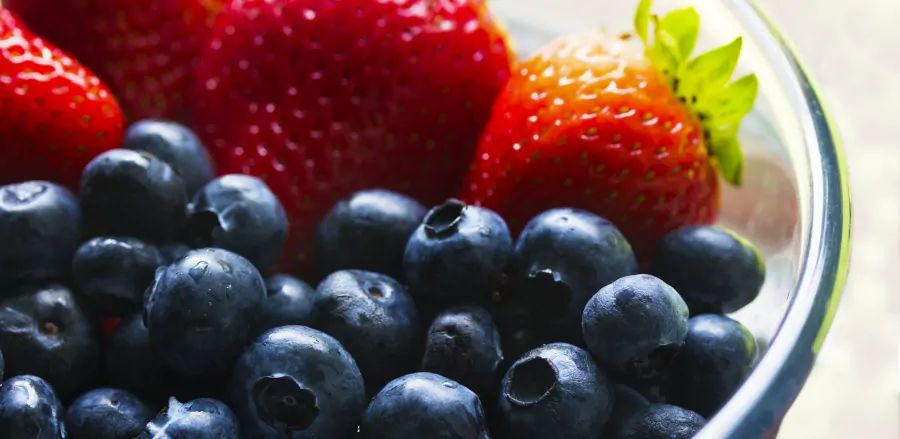
Fat formation in the blood vessels wall is also called plaque.
Plaque consists of oxidized LDL cholesterol and calcified cell residues.
These cause the blood vessels to become thick and uneven. If the plaque gets inflamed there is a risk of it cracking, causing blood to clot and a blood clot develops.
The research shows promising results but the researchers also point out that this particular field of research requires further development.
Blueberries Might Prevent Hypertension (high blood pressure)
A study by the University of East Anglia (UEA) and Harvard University publiched in the American Journal of Clinical Nutrition 2011, showed that anthocyanins blue-red pigments found in blueberries offer protection against hypertension.
The team of UEA and Harvard scientists studied over a 14 year period, about 134,000 women and 47,000 men.
None of the participants had hypertension at the start of the study.
During the study, 35,000 participants developed hypertension.
The researchers concluded that participants consuming the highest amounts of anthocyanins (found mainly in blueberries and strawberries) were 8 per cent less likely to be diagnosed with hypertension than those consuming the lowest amounts.
The effect was stronger in those consuming mainly blueberries rather than in those easting mainly strawberries.
Compared to people who ate no blueberries, those eating at least one serving of blueberries per week were 10 per cent less likely to become hypertensive.
The effect was even stronger in participants under 60.
Blueberries were the richest source of anthocyanin in this particular study.
Other rich sources of anthocyanins include black currants, blood oranges, aubergines and raspberries. University of East Anglia. "Bioactive compounds in berries can reduce high blood pressure." ◳ ScienceDaily. ScienceDaily, 15 January 2011.
Blueberries Keep Your Brain Healthy!
Anthocyanins have also been linked to an increase in neuronal signaling in brain centers. A small study done ◳ at the University of Cincinnati Academic Health Center looked at the effect of daily consumption of wild blueberry juice on older adults with memory changes.
After 12 weeks, participants showed improved memory function.
According to the study the participants showed improvement in paired associate learning and word list recall.
In addition, there were trends suggesting reduced depressive symptoms.
These results are very encouraging suggesting that blueberries might be beneficial not only for memory but also for retarding or postponing the onset of cognitive problems commonly associated with aging.
The researchers themselves say that replication of the findings in a larger, controlled trial will be important to corroborate and amplify this data.
Anthocyanins positive effects on memory was also shown in a study made on mice and the European blueberry ◳ by the Institute of Clinical Medicine-Neurology University of Eastern Finland, Kuopio, Finland.
The mice were fed with anthocyanin rich European blueberry or blackcurrant extracts.
It showed that the berry diets alleviated the spatial working memory deficit, as compared to mice on the control diet.
In their results they suggested that the European blueberry could treat cognitive issues such as dementia and Alzheimer’s.
They conclude that the various phenolic compounds present in the berries might alleviate these neurological issues.
Anthocyanin Might Prevent Hyperactivity
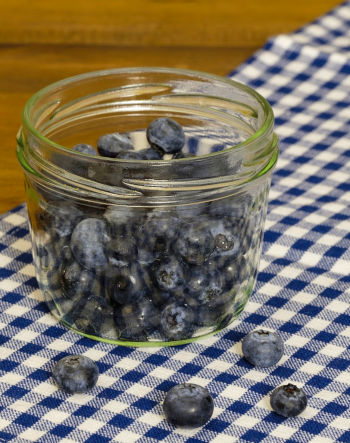
Anthocyanins extracted from plants have been used as food additives.
The use of anthocyanin-based colorants in yogurt drink and some mixed fruit juice is becoming more popular.
Some companies use synthetic dyes in their products. However, these synthetic dyes may be toxic if over consumed.
A clinical trial ◳ involving a total of 153 three-year-old and 144 eight to nine-year-old children suggested that artificial colorants that contained a mixture of:
- Sunset yellow (E110)
- Carmoisine (E122)
- Tartrazine (E102)
- Ponceau 4R (E124)
- Quinoline yellow (E104)
- and Allura red AC (E129)
when combined in the diet with sodium benzoate (E211), resulted in a significant increase of hyperactivity in normal children and aggravated the condition as well at least up to middle childhood.
This finding has drawn great interest in exploring natural food colorants such as anthocyanin as a promising alternative to synthetic food dyes.
Blueberries For Your Eyesight!
Preliminary studies suggest that European blueberry extract may play a positive role in the treatment of retinal disorders and other eye conditions.
European blueberry extract is an antioxidant-rich supplement that ameliorates ocular symptoms. In studies on mice ◳, European blueberry was found to protect retinal cells against degeneration.
Scientific studies ◳ have also supported the effectiveness of European blueberry extract in preventing age-related ocular disorders along with other eye diseases such as cataract and night-blindness.
Blueberries Might Help Your Vision, Cognition And Mood
The University of Reading in England conducted a study 2012 ◳ of the acute effects of low and high doses of blueberry flavonoids on vision, cognition, and mood. The research showed promising positive effects of eating blueberries.
The study points out the importance of eating a diet rich in fruit and vegetables.
There's been a lot of studies in that field in recent years.
25 students took part in the study.
Each participant had to attend three separate sessions where they consumed a drink made from blueberry powder mixed with orange squash.
The participants then completed a series of tests after approximately two hours.
On each occasion the drink contained a different dose of blueberry; a control drink contained no blueberry and the other two drinks contained high and low doses respectively.

The results for each test showed that consuming blueberries caused a slight improvement, i.e. performance was better for the group that consumed the blueberry drink compared to the control group.
It also showed that high doses of blueberry gave a stronger effect than low doses.
I recommend this wonderful bilberry powder #ad if you want to try blueberries in powder form.
It's made by a Finnish producer from high quality wild blueberries.
Recommended Daily Intake Of Blueberries
Adults need between 8-11,000 antioxidant units per day (ORAC units).
If blueberries are your only source of antioxidant intake, you'll need about 114 g to meet the recommended daily intake of antioxidants.
You can get that in less than 1 cup of blueberries.
The recommended daily intake differs depending on age and gender.
If you look at other nutrients, 100 g of blueberries provide about 4% of the recommended daily intake (RDI) of other essential nutrients.
Conclusion: Blueberries Are Packed With Health Benefits!
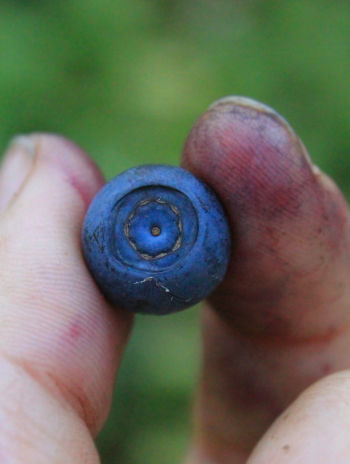
We love blueberries!
We usually pick our berries ourselves but considering the amount of berries we consume on a daily basis it's good to be able to buy wild ones.
There's also the cultivated American variety in the store, which we've tried but we prefer the European variety.
The Bilberry has a stronger flavor and is more nutritious.
The only downside I can think of when it comes to the European blueberry, is that it can easily stain.
If you get it on your clothes it can be a bit tricky to get rid of the stain.
But on the other hand, as the color is directly related to the concentration of the the most nutritious compound in the berry, it's not a hard choice for us to make.
We eat blueberries every day! It’s the wild grown European variety that you'll find in our freezer.
We like to pick them fresh in the summer.
The choices you make has a profound effect on your and your loved ones future health.
Choose to add blueberries to your diet today!
What are blueberries good for?
Blueberry is a real super food! There are several different health benefits you can get from consuming blueberries. For instance, studies show they’re good for your heart, good for your eyesight, might prevent hypertension and even keep your brain healthy.
Are there blueberries in Europe?
Yes, there are blueberries in Europe. Both the European blueberries and cultivated American blueberries. The European blueberry is often called bilberry in the US. In Europe both the European and the cultivated American ones are just called blueberries.
Which is better bilberry or blueberry?
Bilberries, European blueberries, are actually healthier. Both contain lots of nutrients, but the bilberry has a higher concentration of them. The cultivated blueberry is also commonly sprayed with pesticides whereby the bilberry, which grows in the wild, is not.
Is it healthy to eat blueberries everyday?
Yes, it’s very healthy for you. You should eat blueberries every day. Blueberries are believed to have one of the highest antioxidant levels of all common fruits and vegetables.


